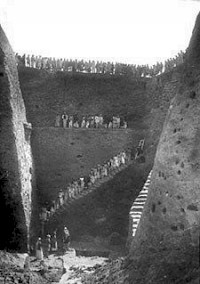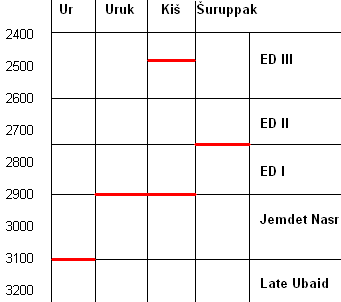The Great Flood: Archaeology?
The Great Flood: mythological story about a great destruction that once befell the earth. There are several variants; the Biblical version is the most famous. The possibility that there is a historical event behind the story (a local flood in southern Babylonia in the twenty-eighth century BCE) cannot be excluded.
Archaeology?

In 1929, the archaeologist Leonard Woolley (1880-1960) announced that he had discovered a 3¾ meter thick clay deposit, which he believed had been laid down by the Great Flood. On top of this deposit was the stratum that contained the famous Royal Tombs, which belong to the period called Early Dynastic III (c.2600-2400 BCE); underneath it was a settlement from what is called the Late Ubaid period, which ended in c.3100. Unfortunately, no trace of a similar deposit was found at Eridu, 23 kilometers from Ur.
At the same time, the excavators of Kiš - situated more to the north - made a similar discovery. They announced evidence for two floods, the younger one contemporary with Woolley's Royal Tombs, the older one between the Jemdet Nasr period and Early Dynastic I (c.2900 BCE). Two years later, evidence for a fourth flood came to the surface at Šuruppak; this one was at the end of the Early Dynastic I period, in c. 2750. Finally, in Uruk, there is evidence for a flood between the layers known as Uruk-2 and Uruk-1, i.e., at the beginning of the Early Dynastic I period, roughly the same age as the older flood at Kiš.
Summing up: there are several large clay deposits, which can be dated to several periods, varying from the Late Ubaid period (in Ur) to the Early Dynastic III period (Kiš). This is a confused picture, but it proves that in southern Iraq, devastating floods were not unheard-of during the first half of the third millennium BCE.

We can be a bit more precise. Several of the kings mentioned in the Sumerian King List as rulers after the Flood, can be dated to the Early Dynastic periods II and III. This suggests that the rulers before the Flood can be dated to Early Dynastic I, and the Deluge, accordingly, to c.2750. The Šuruppak flood fits this date, and it is perhaps not a coincidence that the hero of Eridu Genesis, the Epic of Atrahasis, and the Epic of Gilgameš is a king of Šuruppak. It is likely, therefore, that the event that is behind the myth of the Great Flood can be dated to the end of Early Dynastic I period.
| INTRO | Eridu Genesis | Atrahasis | Gilgameš | Bible | Berossus | Greece | Quran |
| Date | 3d millennium BCE | c.1640 BCE | c.1100 BCE | c.1000-500 BCE | 278 BCE | c.700 BCE? | c.600 CE |
| Revolt | ? | lesser gods | ? | giants? | monsters? | giants | - |
| Hero | Ziusudra | Atrahasis | Ut-napištim | Noah | Xisuthrus | Deucalion | Nuh |
| Country | Šuruppuk | Šuruppak | Šuruppak | - | Sippar | Thessaly | - |
| Destroyer | Enlil | Enlil | Enlil | YHWH | Enlil | Zeus | Allah |
| Warning | Vision | Dream | Indirect order | Direct order | Dream | ? | Direct order |
| Reason | Noise? | Noise | ? | Sin, giants | ? | Sin, giants | Sin |
| Cause | Stormflood | Rain | Stormflood | Rain, fountains | - | Rain, waves | "from the valley" |
| Savior | Enki | Enki | Enki | YHWH | Enki | Prometheus | Allah |
| Period | 7 days | 7 days | 7 days | 150/40 days | "quickly" | 9 days | ? |
| Birds | ? | ? | raven, dove, swallow | doves/raven | "several" | none | - |
| Destination | ? | - | Nimuš | Ararat | Gordyene | Parnassus | Al-Gudi |
| Fate | Eternal life | Eternal life | Eternal life | 3 sons | Eternal life | 3 grandsons | - |
| TEXT | TEXT | TEXT | TEXT | TEXT | TEXT | TEXT | |
| COMMENT | COMMENT | COMMENT | 2 Sources | COMMENT | COMMENT | - | |
| ARCHEOLOGY? | COMPARISON | ||||||